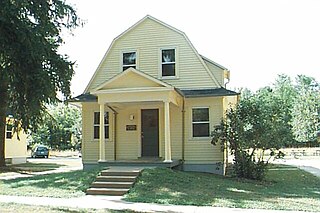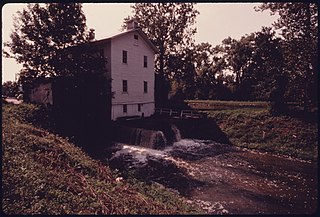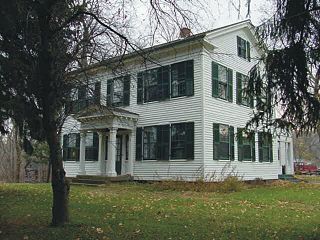
Peninsula is a village in Summit County, Ohio, United States. The population was 565 at the 2010 census. It is part of the Akron Metropolitan Statistical Area.

Cuyahoga Valley National Park is an American national park that preserves and reclaims the rural landscape along the Cuyahoga River between Akron and Cleveland in Northeast Ohio.

The Ohio and Erie Canal was a canal constructed during the 1820s and early 1830s in Ohio. It connected Akron with the Cuyahoga River near its outlet on Lake Erie in Cleveland, and a few years later, with the Ohio River near Portsmouth. It also had connections to other canal systems in Pennsylvania.

First Ladies National Historic Site is a United States National Historic Site located in Canton, Ohio. During her residency in Washington, D.C. Mary Regula, wife of Ohio congressman Ralph Regula, spoke regularly about the nation's first ladies. Recognizing the paucity of research materials available she created a board to raise funds and for a historian to assemble a comprehensive bibliography on American first ladies. From these inspirations came a National First Ladies’ Library, established in 1996, and the First Ladies National Historic Site. The site was established in 2000 to commemorate all the United States first ladies and comprises two buildings: the Ida Saxton McKinley Historic Home and the Education & Research Center. The act that established this site was at the 106th congress meeting at the second session. The act to establish this site was bundled under other laws and is known as an omnibus. The purpose of the site is to inform the public about the influences that the First ladies of the United had on the public and to the president. To teach the public about their contributions and to not be remembered as just the wives of the President of the United States. Tours start at the Education & Research Center, located one block north of the Saxton McKinley house on Market Avenue. The 1895 building, formerly the City National Bank Building, was given to the National First Ladies’ Library in 1997.

James A. Garfield National Historic Site is a United States National Historic Site located in Mentor, Ohio. The site preserves the Lawnfield estate and surrounding property of James Abram Garfield, the 20th president of the United States, and includes the first presidential library established in the United States.

This is a list of properties and districts in Ohio that are listed on the National Register of Historic Places. There are over 4.000 in total. Of these, 73 are National Historic Landmarks. There are listings in each of Ohio's 88 counties.

The New Hampshire Governor's Mansion, known as "Bridges House", is the official residence of the governor of New Hampshire and the governor's family. Bridges House, located at 21 Mountain Road in Concord, the capital of New Hampshire, has served as the governor's official residence since 1969. Built in 1836, it was listed on the National Register of Historic Places in December 2005, and the New Hampshire State Register of Historic Places in July 2005.

The Jaite Mill Historic District, also known as Jaite, is a nationally recognized historic district in Cuyahoga and Summit counties in the U.S. state of Ohio. The Cuyahoga County portion of the district is located in the city of Brecksville, while the Summit County portion is located in Sagamore Hills Township. Built in 1903 as the Jaite Company Paper Mill, its center is at the intersection of Vaughn and Riverview roads, north of the crossing of Interstates 80 and 271.

This is a list of the National Register of Historic Places listings in Cleveland, Ohio.

Tinkers Creek Aqueduct is an aqueduct that was constructed to bridge the Ohio and Erie Canal over Tinkers Creek near its confluence with the Cuyahoga River in Valley View, Ohio. It is a relatively rare surviving example of an Ohio and Erie Canal aqueduct. It was originally constructed in 1825-1827 by, and re-built due to flood damage in 1845 and 1905. Tinkers Creek Aqueduct was included in a National Historic Landmark district established in 1966, and it was separately listed on the National Register of Historic Places in 1979. The original Tinkers Creek Aqueduct was a wood plank, steel truss, and Ashlar-sandstone structure constructed in 1827, south of the present aqueduct's location. Cuyahoga River and Tinkers Creek flooding caused continual damage to the original aqueduct, so successive structures were built in 1845 and 1905 in the present location. Today, Tinkers Creek Aqueduct is the only aqueduct which remains of the four original aqueducts in the Cuyahoga Valley. Of Furnace Run Aqueduct, Mill Creek Aqueduct, Peninsula Aqueduct, and Aqueduct; Mill Creek Aqueduct, of newer construction, is the only aqueduct which still carries Ohio and Erie Canal water. After 102 years of flooding, weathering, and deterioration, Tinkers Creek Aqueduct was removed in 2007. The National Park Service is currently working on Phase II of the project to reconstruct it from newer materials.

Sacred Heart of Jesus Catholic Church is a parish of the Roman Catholic Church in McCartyville, Ohio, United States. Founded in the late nineteenth century, it remains an active parish to the present day. Its rectory, which was built in the early twentieth century, has been designated a historic site.

The Boston Mills Historic District is a historic district in the Cuyahoga Valley National Park in Northeast Ohio in the United States. With the opening of the Ohio and Erie Canal in 1827, people began to settle in this vicinity. By 1842, there was a water-powered mill, a large warehouse, a boat-yard, two stores and a hotel, and the population was around 300. A number of houses and other buildings dating back to that period remain.
This is a list of the National Register of Historic Places listings in Cuyahoga Valley National Park.

Peninsula Village Historic District is a historic district located on both sides of Ohio State Route 303 in Peninsula, Ohio. The district encompasses the historic core of Peninsula, which is situated inside of Cuyahoga Valley National Park. Peninsula was settled by Hermon Bronson in 1824 and platted in 1837; in its early years, it was a stop along the Ohio and Erie Canal and home to a mill on the Cuyahoga River. Canal traffic and the construction of the Valley Railway in 1875 spurred the village's continued economic growth through the nineteenth century. The district includes examples of Greek Revival, Federal style, and Italianate architecture, all of which were popular nineteenth century styles. Significant buildings in the district include the Town Hall, a railroad depot, Peninsula High School, the G.A.R. Hall, and three churches.

Blackstone River Valley National Historical Park is a National Park Service unit in the states of Rhode Island and Massachusetts. The park was created for the purpose of preserving, protecting, and interpreting the industrial heritage of the Blackstone River Valley and the urban, rural, and agricultural landscape of that region. The Blackstone River Valley was the site of some of the earliest successful textile mills in the United States, and these mills contributed significantly to the earliest American Industrial Revolution. The subsequent construction of the Blackstone Canal, a few years after the successful completion of the Erie Canal, helped to sustain the region's industrial strength.
Whittlesey culture is an archaeological designation for native people who lived in northeastern Ohio during the Late prehistoric and Early Contact period between A.D. 1000 to 1640. They flourished as an agrarian society by 1500—growing maize, beans, and squash—when their population began to decrease due to disease, malnutrition, and warfare. There was a period of long, cold winters that would have impacted their success cultivating food from about 1500. The Whittlesey culture people created a distinctive style of pottery and built villages that were designed to be defensive, set high on promontories with steep cliffs and then surrounded by ditches or stockades. The villages were established on the Lake Erie plain or overlooking river and streams. About 1640, Whittlesey villages were abandoned and due to the displacement of native groups during the early contact period with Europeans, it is not known where or how they relocated.

The Botzum Farm is a historic farm at 3486 Riverview Road in Cuyahoga Valley National Park in the U.S. state of Ohio. The farm was founded by the Botzum family, who immigrated to the United States from Germany in the 1830s. According to family history, the family lost their possessions to a pirate attack during their voyage to the U.S., and they were nearly abducted by South American slavers in New York City before traveling to Ohio. While the family purchased the land from the Connecticut Land Company in the 1840s, the current buildings on the farm were not built until after Conrad Botzum settled there in 1883. The farm raised livestock and grew crops, and particularly outpaced its neighbors in the former; at one point it had 65 sheep and 31 hogs, both several times higher than the local average. The farmstead's main buildings are the 1906 concrete block farmhouse, the 1884 Pomeranian barn, and the 1898 bank barn; it also includes two summer kitchens, a privy, a shed, and a well.

Wilson Feed Mill, also known as Alexander's Mill, is a historic gristmill at 7604 Canal Road in Cuyahoga Valley National Park in the U.S. state of Ohio. Andrew and Robert Alexander built the mill on the Ohio and Erie Canal in 1855 to grind flour for local farmers. At the time, the Cleveland area was a major wheat-producing region, in part because the canal let farmers ship flour across the Great Lakes. In 1900, Thomas and Emma Wilson bought the mill and expanded it to serve larger businesses. They also began grinding animal feed instead of flour at the mill in order to serve the growing feed market. The mill was the last operating mill in the Cuyahoga Valley and ran on water power through 1970.

The Boston Land and Manufacturing Company Store, also known as the Jim Brown Tavern, is a historic building at 1556 Boston Mills Road in Boston, Ohio. The store was built in 1835 for the Boston Land and Manufacturing Company, which used it as a general store and post office until 1904. The building's design includes elements of the Federal and Greek Revival styles. It features a gable front with a fanlight, a wraparound front porch, and Ionic pilasters. In 1905, the store was converted to a private house. It is currently a park store for Cuyahoga Valley National Park and a trailhead on the Ohio and Erie Canal Towpath Trail.

The George Stanford Farm is a historic farm at 6093 Stanford Road in Boston Township, Ohio, within the boundaries of Cuyahoga Valley National Park. The farm, which overlooks the Cuyahoga River and Ohio and Erie Canal, was settled in 1806 by James and Polly Stanford and their children. Their son George built the main farmhouse circa 1830. The Stafford family played an important role in the history of Boston Township; James reportedly suggested its name, and both George and his son George C. held government offices in the township. The farmhouse has a Greek Revival design with a pedimented front porch supported by Greek columns, pilasters flanking the entrance, six-over-six windows, and a gable roof with a box cornice. The property also includes a barn, a springhouse, a garage, a smoke house, a chicken coop, and a corn crib.

















